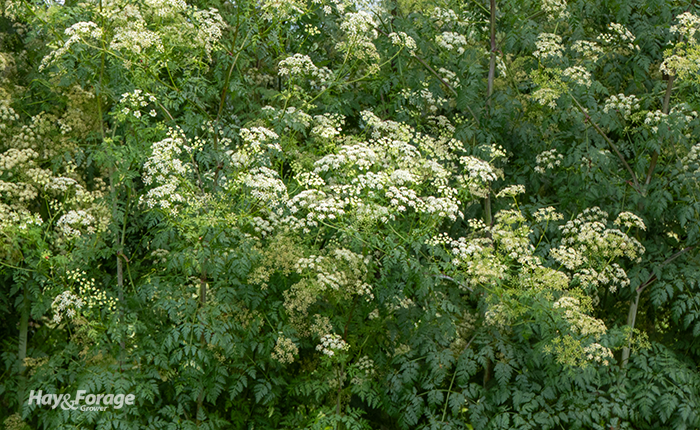
Warmer winter temperatures might welcome an early growing season, but this head start won’t be exclusive to forage. Weeds like poison hemlock that can be deadly to livestock may sooner become an issue in pasture and hayfields.
In a recent article from Ohio State University Extension, J.D. Green, Megan Romano, and Michelle Arnold explain that poison hemlock is classified as a biennial weed, but it can act like an annual if plants germinate in the fall and maintain a semi-dormant state through the winter. In this case, weeds can resume active growth and progress toward reproductive stages in early spring.
Young poison hemlock plants grow in a rosette pattern with shiny, triangular, fern-like leaves. Mature weeds develop erect, hollow, purple-spotted stems that can reach 6 to 8 feet tall with alternately arranged, pinnately compound leaves. Poison hemlock has white compound umbel flowers at the end of its terminal stalks, which can create confusion among it and other plants like wild parsnip and wild carrot.
“Poison hemlock foliage has an unpleasant odor that is detectable when near the plant or when a stem or leaf is crushed,” the researchers continue. “This weed is often associated with areas that have moist soil conditions, but it can also survive in dry sites,” they add.
Chemical weed control will be most successful when plants are still vegetative, and the best way to prevent future poison hemlock infestations is to eradicate weeds before they go to seed. The researchers recommend spraying vegetative weeds with products that contain 2, 4-D, dicamba, and/or aminopyralid when daytime temperatures reach 60ºF, but they point out that herbicide treatments will become less effective as plants mature.
“It is too late to utilize herbicide control methods after plants have produced flowers,” the researchers assert. “Therefore, mechanical control efforts such as mowing or cutting down individual plants should be initiated just before peak flower production to avoid or reduce the number of new seeds produced.”
Fatal effects
Targeting poison hemlock in a vegetative stage is critical since weeds only reproduce through seed, and a single plant can produce up to 40,000 of them. Poison hemlock also contains high concentrations of gamma-coniceine and coniine, which are two alkaloids that are fatal to cattle, sheep, horses, pigs, and humans. Although vegetative growth contains greater amounts of the more toxic gamma-coniceine, this compound is eventually reduced to coniine in mature plant tissue and seeds.
Poison hemlock is relatively unpalatable, but livestock will graze it if other forage supplies are scarce. Weeds can also contaminate forage that is harvested for hay or silage, and dried plant material contains the highest levels of coniine. The researchers point out that toxicity can vary with growth stage at harvest, temperature, moisture conditions, and geographic location; however, as little as 0.2% body weight of poison hemlock has been shown to be deadly for cattle.
“Symptoms of acute poisoning can occur rapidly after ingestion of plant material, anywhere within 30 minutes to two hours,” the researchers caution. “Initially, the affected animals may develop nervousness, salivation, tearing, frequent urination, and signs of abdominal pain.”
These symptoms can progress to muscle tremors, incoordination, weakness, difficulty breathing, and death due to respiratory failure. The researchers add that subacute intoxication in pregnant cattle can interfere with fetus development and cause congenital birth defects in calves, including severe limb deformities, joint rigidity, rib cage anomalies, vertebral curvature, and cleft palate.
Avoid feeding livestock hay or silage that may contain poison hemlock. Scout pastures for vegetative weeds and be proactive with control methods before the plants develop flowers this spring. Finally, when using herbicide on poison hemlock, the researchers remind farmers to exclude animals from treated areas.

